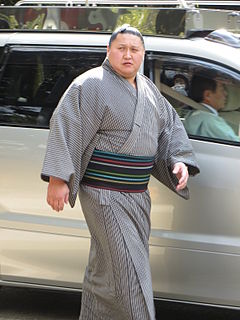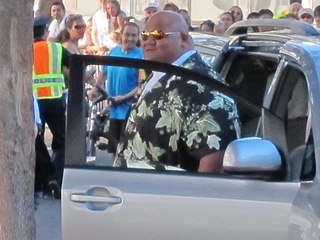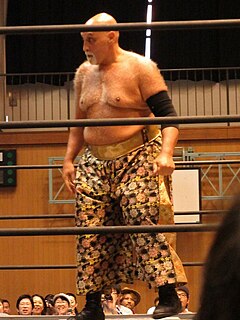
Taihō Kōki was the 48th yokozuna in the Japanese sport of sumo wrestling. He became a yokozuna in 1961 at the age of 21, the youngest ever at the time. He won 32 tournament championships between 1960 and 1971, a record that was unequalled until 2014. His dominance was such that he won six tournaments in a row on two separate occasions. He is the only wrestler to win at least one championship every year of his top division career, and he won 45 consecutive matches between 1968 and 1969, which at the time the best winning streak since Futabayama in the 1930s. He was a popular grand champion, especially amongst women and children. After retiring from active competition he became a sumo coach, although health problems meant he had limited success. When he died in January 2013 he was widely cited as the greatest sumo wrestler of the post-war period. Since then Hakuhō, who regarded Taihō as a mentor, surpassed his record by winning his 33rd championship in January 2015.

Toshimitsu Obata known as Kitanoumi Toshimitsu (北の湖敏満), was a sumo wrestler. He was the dominant yokozuna in sumo during the 1970s. Kitanoumi was promoted to yokozuna at the age 21, becoming the youngest ever to achieve sumo's top rank, and he remained a yokozuna for a record 63 tournaments. He won 24 tournament championships during his career and was one of a series of truly great yokozuna who came from Hokkaidō, the northernmost main island of Japan. At the time of his death he still held the record for most bouts won as a yokozuna (670). Following his retirement in 1985 he established the Kitanoumi stable. He was chairman of the Japan Sumo Association from 2002 until 2008, and from 2012 until his death.
Takamiyama Daigorō is a former sumo wrestler, the first foreign-born wrestler to win the top division championship. His highest rank was sekiwake. His active career spanned twenty years from 1964 to 1984, and he set a number of longevity records, including most tournaments ranked in the top makuuchi division, and most consecutive top division appearances. He is also the first foreign-born wrestler ever to take charge of a training stable, founding Azumazeki stable in 1986. His most successful wrestler was fellow Hawaiian Akebono who reached the highest rank of yokozuna in 1993. He retired as a coach in 2009.

Kyokutenhō Masaru in Nalaikh, Ulan Bator, Mongolia is a former professional sumo wrestler. He made his debut in March 1992 out of Ōshima stable, with the first group of Mongolians ever to join the sport in Japan, reaching the top makuuchi division in January 1998. In his exceptionally long career he received seven special prizes for Fighting Spirit, and won one yūshō, in May 2012 from the maegashira ranks, which made him at 37 the oldest first–time yūshō winner in sumo history, and he was runner-up in one other tournament. His highest rank was sekiwake, which he held on three occasions. He was the first wrestler since the 1950s to be ranked in the top division after the age of 40. He made more appearances in the top division than any other wrestler at 1470, and only Ōshio fought more than his 1870 career bouts. He announced his retirement in July 2015 and declared his intention to stay in sumo as an elder, having acquired Japanese citizenship in 2005. In 2017 he became the head coach of Tomozuna stable and he is known as Tomozuna-oyakata.

Teila Tuli, also known as Taylor Wily is an American actor and former sumo wrestler and mixed martial artist. He is from Laie, Hawaii and is of Samoan descent. He is commonly known for his recurring role as Kamekona Tupuola on Hawaii Five-0.

Hoshitango Imachi is an Argentine-born Japanese former professional sumo wrestler and current professional wrestler. His highest rank was Jūryō 3.

Daimanazuru Kenji is a former sumo wrestler from Kawakami, Yoshino District, Nara, Japan. He began his professional career in 1992, and spent a total of 19 tournaments in the top two divisions, peaking at maegashira 16 in 2006. He retired at the end of the January 2010 tournament and has chosen to work outside of the Sumo Association.

Ōnomatsu stable is a stable of sumo wrestlers, one of the Nishonoseki ichimon or group of stables. It was founded in its modern form on 1 October 1994 by Masurao Hiroo, who branched off from the now defunct Oshiogawa stable. His first wrestler to reach the top makuuchi division was Katayama in 2005. The now retired Wakakōyū reached komusubi in 2012, as did Ōnoshō in 2017. The stable's most successful foreign recruit has been the Russian former maegashira Amūru, who retired in 2018.

Ōshio Kenji is a former sumo wrestler from Kitakyushu, Japan. His highest rank was komusubi. His career lasted twenty six years, from 1962 until 1988, and he holds the record for the most bouts contested in professional sumo. After his retirement at the age of 40 he became an elder of the Japan Sumo Association and set up Shikihide stable in 1992. He left the Sumo Association upon turning 65 in 2013.

Tochinowaka Kiyotaka is a former sumo wrestler from Wakayama Prefecture, Japan. A former amateur champion, he turned professional in 1985, reaching the top makuuchi division in 1987. His highest rank was sekiwake. He was a runner-up in one tournament and earned six special prizes and four kinboshi. After 76 tournaments and 1114 bouts in the top division he retired in 1999. He is now an elder of the Japan Sumo Association and the head coach of Kasugano stable.

Musashimaru Kōyō is a former sumo wrestler. He made his professional debut in 1989, and reached the top makuuchi division in 1991. After reaching ozeki rank in 1994 his progress seemed to stall, but in 1999 he became the second foreign-born wrestler in history to reach the rank of yokozuna. He won over 700 top division bouts and took twelve top division tournament championships during his career. Musashimaru's sheer 235 kg (518 lb) bulk combined with 1.92 m of height made him a formidable opponent, and he was remarkably consistent and injury-free for most of his career. An amiable personality, his fan base was helped by a surprising facial resemblance to Japanese warrior hero Saigō Takamori. After retiring in 2003, he became an elder of the Japan Sumo Association and founded the Musashigawa stable in 2013.
The following are the events in professional sumo in 1998.

Gagamaru Masaru is a professional sumo wrestler from Georgia. The third Georgian national after Kokkai and Tochinoshin to make the top makuuchi division, he made his professional debut in November 2005, reaching the jūryō division in November 2009 and makuuchi in July 2010. Originally from Kise stable, he briefly competed for the Kitanoumi stable before moving back to the Kise stable after it was re-established. His highest rank has been komusubi. He has won two special prizes for Fighting Spirit and has been runner-up in one tournament.

Daidō Kenji is a former professional sumo wrestler (rikishi) from Katsushika, Tokyo, Japan. He made his debut in 2005, reaching the top division six years later, debuting in the July, 2011 tournament. His highest rank was maegashira #8. He is now a sumo coach.

Ganyū Kenji is a former sumo wrestler from Himeji, Hyōgo, Japan. He made his professional debut in March 1986, and reached the top division in March 1996. His highest rank was maegashira 1. In May 1999 he continued fighting in the tournament despite having ligament damage in his ankle, in search of the eighth win that would give him a winning record. He was also restricted by persistent knee problems. He retired in May 2000 and became an elder in the Japan Sumo Association under the name Yamahibiki. He took over the running over the Kitanoumi stable in November 2015 after the death of its founder and head, former yokozuna Kitanoumi. The stable was renamed Yamahibiki stable. He was elected to the Sumo Association's board of directors in 2018.
Asahisato Kenji is a former sumo wrestler from Ikeda, Osaka, Japan. His active career spanned 17 years and 102 tournaments from 1981 until 1998, and his highest rank was maegashira 14. Upon his retirement he became an elder of the Japan Sumo Association and he took charge of Nakagawa stable in January 2017.
Tōryū Kenji is a former sumo wrestler from Kakogawa, Hyōgo, Japan. He made his professional debut in March 1974, and reached the top division in November 1979. His highest rank was sekiwake. He retired in January 1990.
Asasegawa Takeya is a former sumo wrestler from Naniwa-ku, Osaka, Japan. He made his professional debut in May 1957 and reached the top division in March 1964. His highest rank was maegashira 1. Upon retirement from active competition he became an elder in the Japan Sumo Association under the name Urakaze. He left the Association in January 1975.
Daimonji Kenji is a former sumo wrestler from Kyōto, Japan. He made his professional debut in March 1956 and reached the top division in November 1966. His highest rank was maegashira 5. Upon retirement from active competition he became an elder in the Japan Sumo Association, under the name Nishiiwa. He coached at Taihō/Ōtake stable, until reaching the Sumo Association's mandatory retirement age of 65 in February 2005.
















